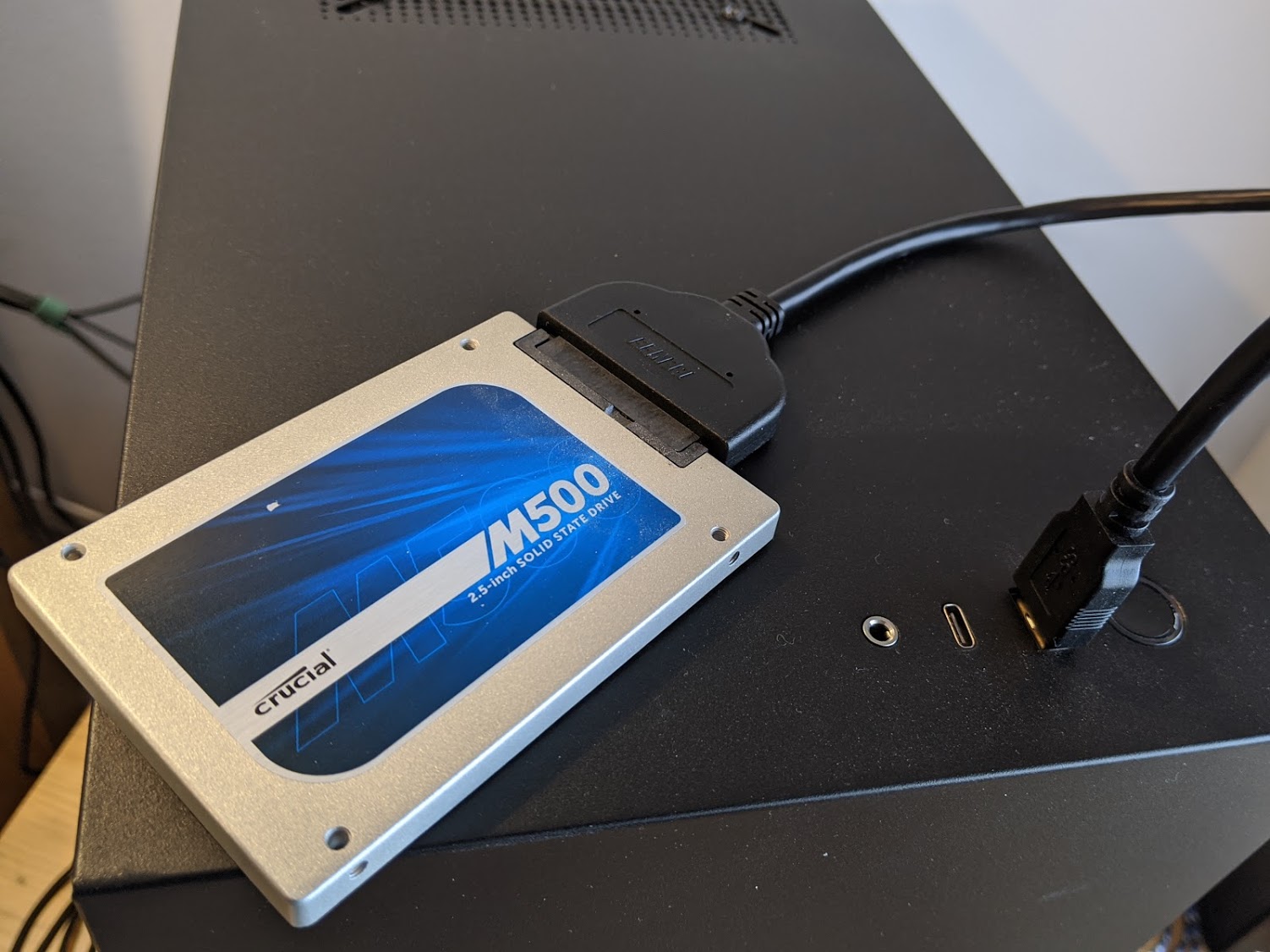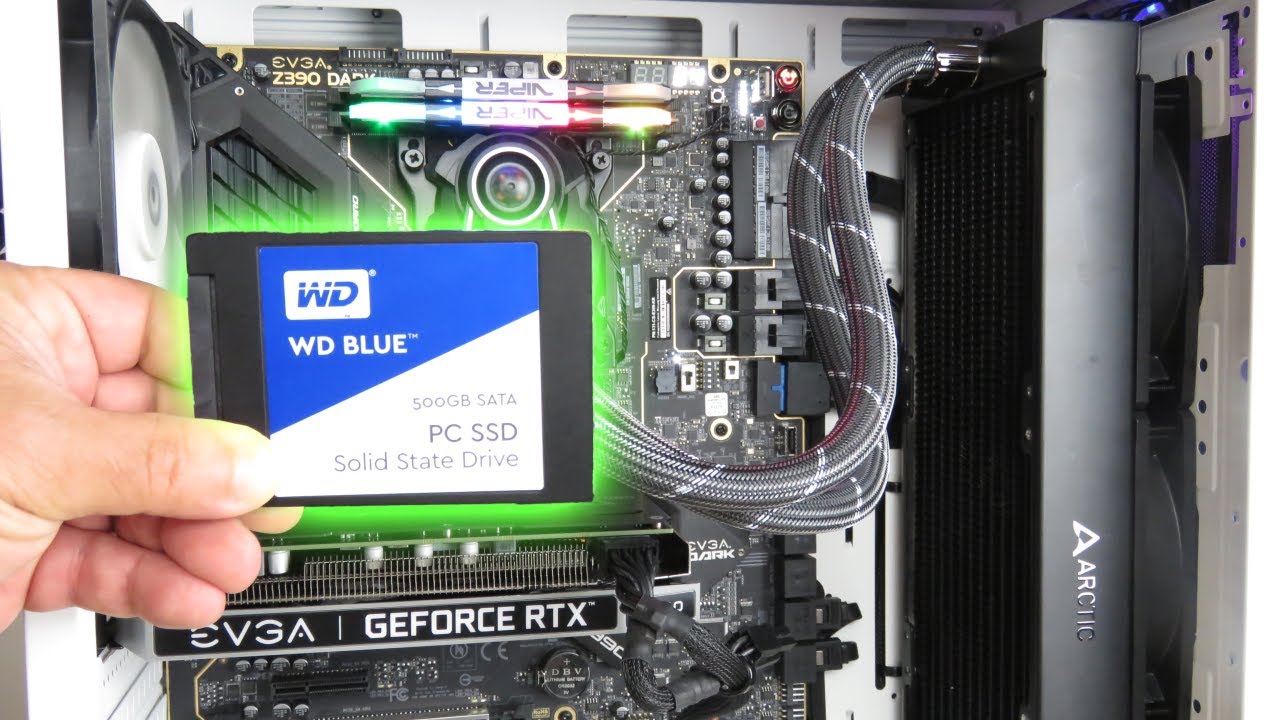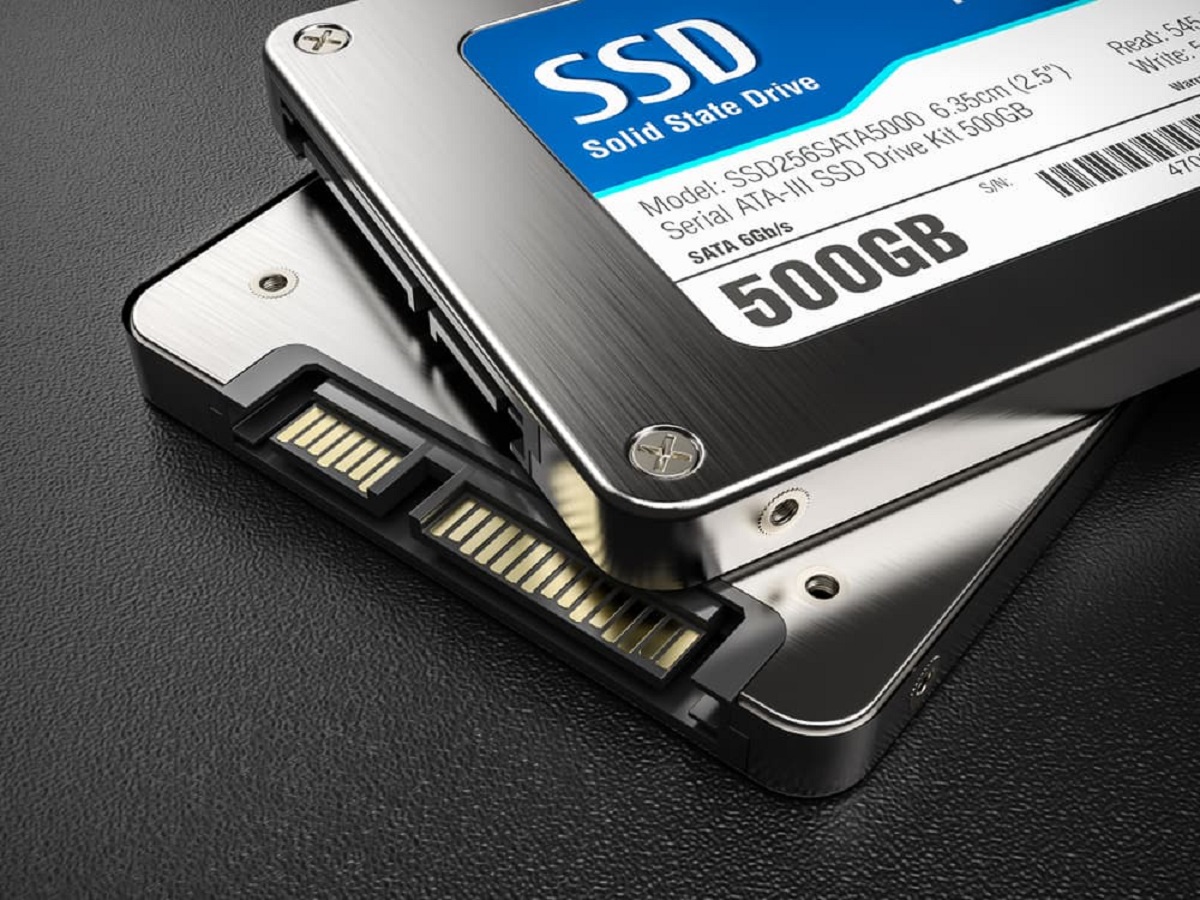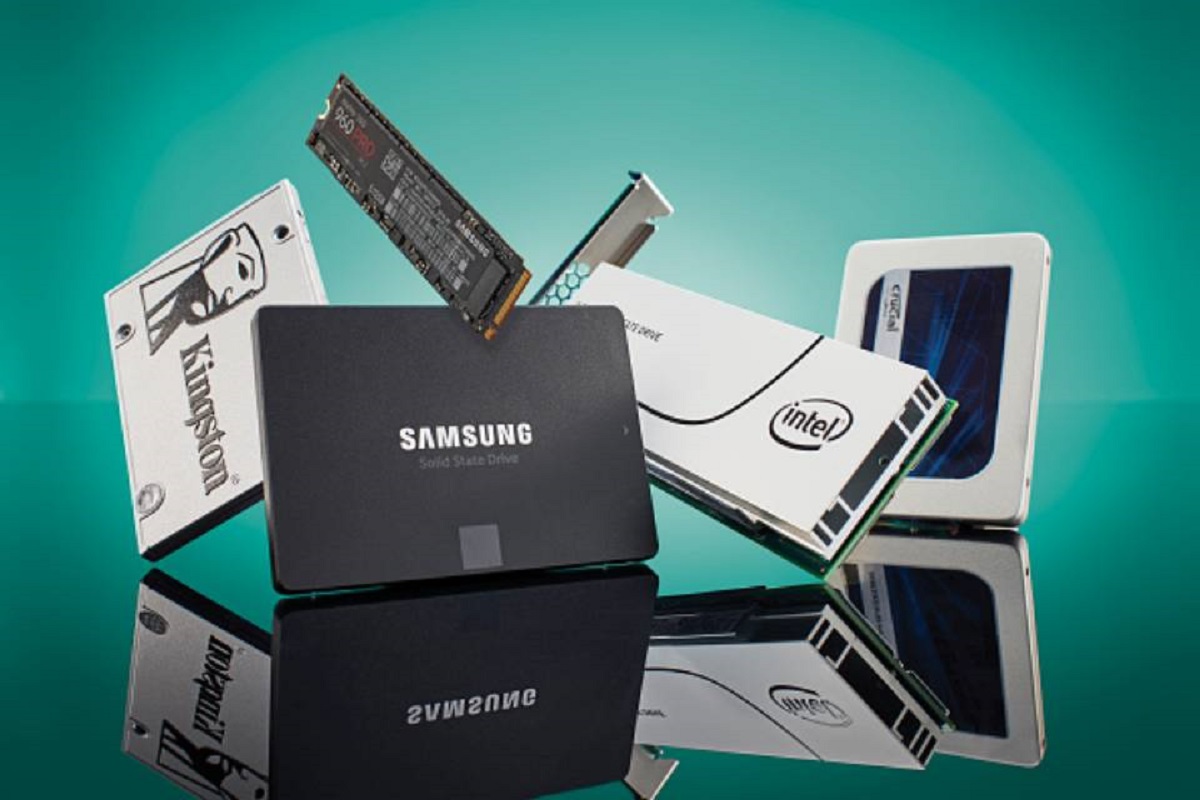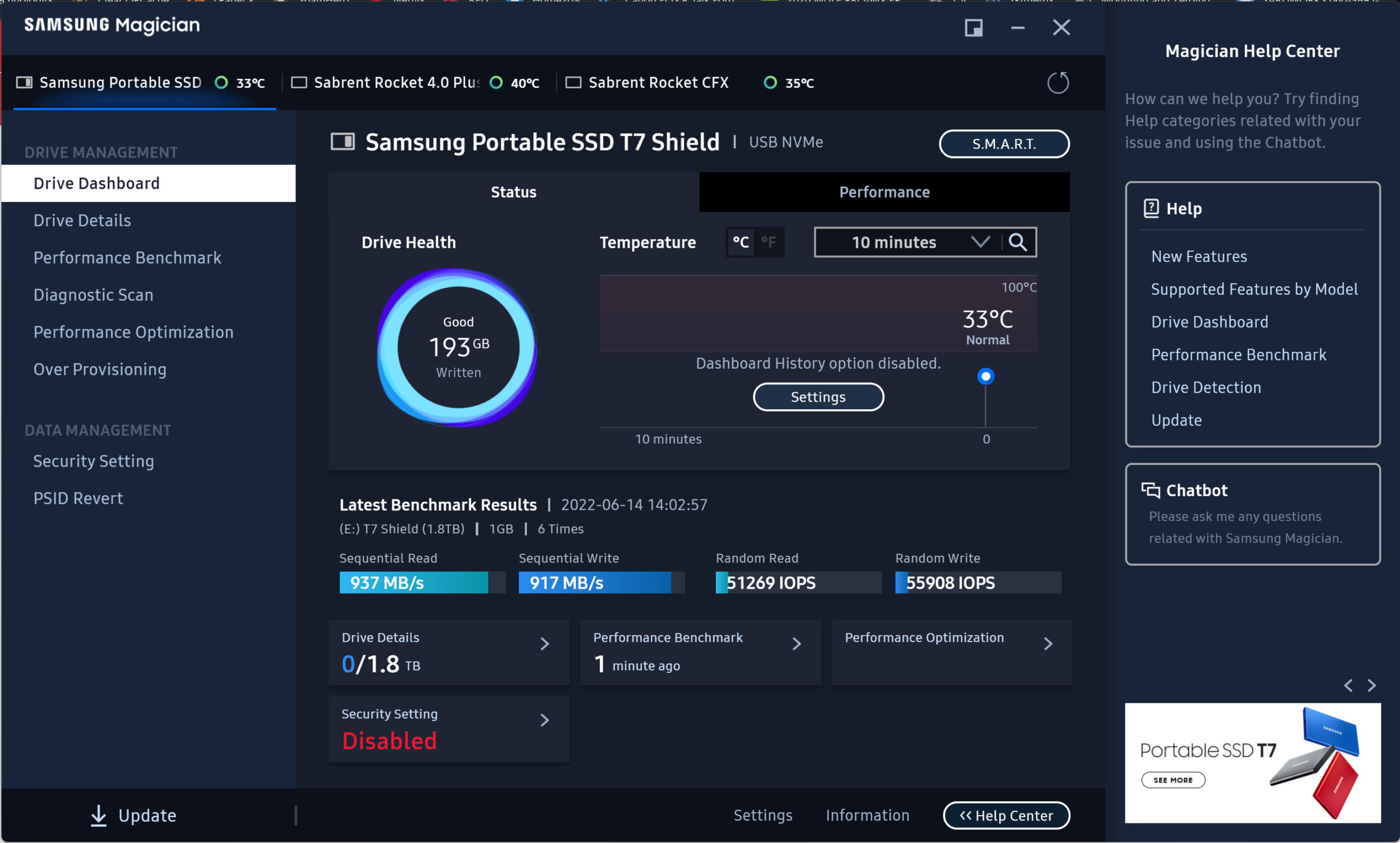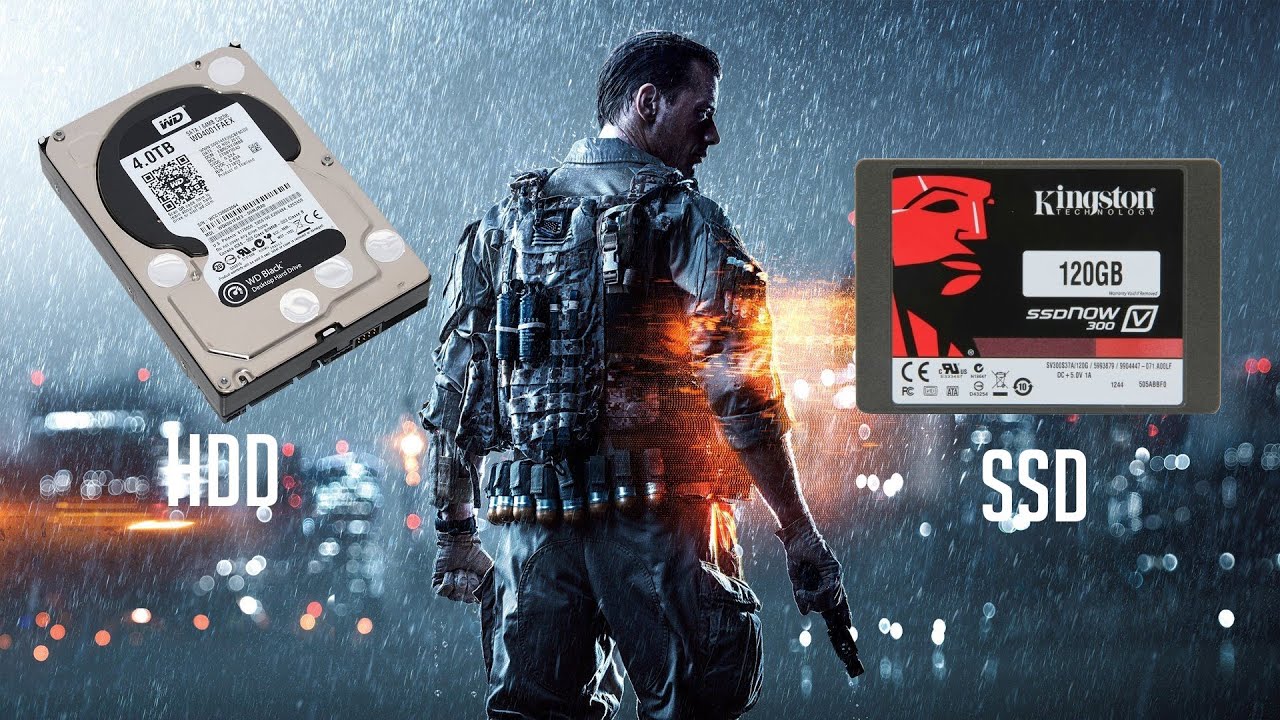Introduction
Welcome to the world of solid-state drives (SSDs), where storage space is limited but performance is blazing fast. If you’ve recently noticed that your SSD is filling up quickly, you’re not alone. Many users encounter this issue and wonder why their SSDs are becoming full, despite their smaller storage capacity compared to traditional hard drives.
Before we dive into the reasons behind your SSD’s fullness, let’s briefly understand what an SSD is. An SSD is a type of storage device that uses flash memory to store and retrieve data. Unlike traditional hard drives, which rely on spinning disks, SSDs offer faster read and write speeds, making them ideal for improving overall system performance.
With the increasing reliance on digital files and media, managing storage space on an SSD becomes critical. Understanding how files are stored and accessed on an SSD can shed light on why your storage is quickly being consumed.
In this article, we’ll explore the various factors that can contribute to your SSD’s fullness. We’ll also provide you with some practical tips and strategies to manage your SSD’s storage effectively and optimize its performance.
What is an SSD?
A solid-state drive (SSD) is a type of storage device that uses flash memory to store and retrieve data. Unlike traditional hard drives, which employ spinning disks and magnetic storage technology, SSDs utilize non-volatile memory chips to store data. This design enables faster read and write speeds, improved durability, and reduced power consumption.
SSDs have gained popularity in recent years due to their significant advantages over traditional hard drives. The absence of movable parts in SSDs eliminates the risk of mechanical failure and fragmentation, making them more reliable and resilient. Additionally, with no disks to spin up, SSDs are faster at accessing and transferring data, resulting in shorter boot times and quicker application launches.
Another key advantage of SSDs is their compact size. These drives are typically smaller and lighter than traditional hard drives, making them an excellent choice for devices such as laptops and ultrabooks, where portability is essential.
When it comes to storage capacity, SSDs typically offer smaller capacities compared to traditional hard drives. However, advancements in technology have led to larger capacity SSDs becoming more affordable and readily available in recent years. Despite the smaller storage size, many users find the enhanced performance and reliability of SSDs to be worth the trade-off.
It’s important to note that SSDs can be installed in various devices, including desktop computers, laptops, gaming consoles, and even external storage devices. By replacing the traditional hard drive with an SSD, users can experience significant performance improvements and a more responsive computing experience.
In summary, an SSD is a modern storage device that utilizes non-volatile flash memory to store and retrieve data. Its advantages include faster read and write speeds, improved durability, reduced power consumption, and smaller form factor. Despite the smaller storage capacity compared to traditional hard drives, the enhanced performance and reliability of SSDs make them a popular choice among users looking to optimize their computing experience.
Understanding storage on an SSD
To fully grasp why your SSD may be filling up quickly, it’s important to understand how storage works on these devices. Unlike traditional hard drives that use magnetic platters to store data, SSDs rely on a grid of memory cells to store information.
Each memory cell in an SSD can store multiple bits of data, with the most common being TLC (triple-level cell) or QLC (quad-level cell) technology. This allows SSDs to offer higher storage densities while still maintaining fast read and write speeds.
However, one trade-off of this storage method is that SSDs have a limited number of write cycles per cell. This means that over time, as data is constantly written, erased, and rewritten, the cells can wear out and become less reliable. To mitigate this, SSDs employ a technique called wear leveling that evenly distributes write operations throughout the drive, prolonging its lifespan.
SSDs also have a process called garbage collection, which helps free up space by identifying and consolidating invalid or deleted data. When you delete a file on an SSD, the drive marks the space occupied by that file as “free” and ready for new data. However, the actual data is not immediately erased. Instead, the garbage collection process will eventually clean up these marked spaces, making them available for new data storage.
Additionally, SSDs require a certain amount of empty space or overprovisioning to perform efficiently. This overprovisioning helps maintain consistent performance and improves the lifespan of the drive. The more overprovisioning available, the better the SSD can handle wear leveling and garbage collection.
In summary, SSDs use a grid of memory cells to store data, offering high storage densities and fast read and write speeds. They employ wear leveling and garbage collection techniques to ensure data is distributed evenly and unnecessary data is efficiently deleted. Additionally, the presence of overprovisioning helps maintain performance and prolong the lifespan of the drive.
Reasons why your SSD may be full
There are several reasons why your SSD may be filling up quickly. Let’s explore some common factors that contribute to storage consumption on SSDs:
- Large files and downloads: One of the primary culprits for filling up your SSD is the presence of large files and downloads. High-resolution images, videos, and software installers can quickly take up a significant amount of space on your drive.
- Installed programs and applications: Another factor that can contribute to a full SSD is the accumulation of installed programs and applications over time. These files not only occupy space on the drive but may also generate temporary files and cache that further consume storage.
- Temporary files and cache: Temporary files, cache, and system logs created by your operating system and applications can gradually accumulate and fill up your SSD. These files are often necessary for smooth system operation but can sometimes exceed their intended purpose, resulting in unnecessary storage consumption.
- System backups and restore points: If you have automatic system backup and restore point features enabled, your SSD may be filling up with these backup files. While backups are important for data protection, it’s essential to manage them properly to avoid excessive storage usage.
- Deleted files and recycle bin: Even after deleting files, they may still occupy space on your SSD until they are permanently removed from the recycle bin. Over time, the accumulation of deleted files can contribute to storage fullness.
- Overwhelmed storage capacity: Lastly, it’s important to consider whether your SSD’s capacity is simply being overwhelmed by the sheer volume of data you are trying to store. If you frequently work with large files or have an extensive media library, it’s possible that your SSD’s storage capacity is insufficient for your needs.
Understanding these reasons can help you identify the causes behind your SSD’s fullness. By addressing these factors and implementing effective storage management practices, you can regain control over your SSD and optimize its storage usage.
Large files and downloads
One of the main reasons your SSD may be filling up quickly is the presence of large files and downloads on your drive. Whether it’s high-resolution images, videos, or software installers, these files can take up a significant amount of storage space.
When it comes to multimedia files, such as photos and videos, their sizes can be substantial, especially if they are captured in high resolution or recorded at longer durations. Additionally, if you frequently download large files from the internet, such as movies or game installations, they can quickly consume a significant portion of your SSD’s capacity.
To address this issue, it’s important to regularly review and manage your collection of large files. Evaluate if you truly need to keep all the files on your SSD or if you can transfer them to an external storage device or cloud storage service.
Consider organizing your files into folders based on categories or projects, making it easier to locate and manage specific files. You can also compress files to reduce their size without compromising their quality, saving valuable space on your SSD.
Additionally, adopting a habit of periodically cleaning up your downloads folder can prevent it from becoming a repository of unnecessary files. Sort through the folder and delete any files that you no longer need.
When it comes to software installers, it’s a good practice to delete the installer files once the program or application has been successfully installed. These installer files often take up a significant amount of space and can easily be replaced if needed in the future.
In summary, large files and downloads can quickly fill up your SSD’s storage capacity. Regularly evaluate your collection of large files, transfer them to external storage or the cloud if necessary, and delete unnecessary files and installer files to ensure optimal storage management on your SSD.
Installed programs and applications
Installed programs and applications are another common reason why your SSD may be filling up. As you install new software and applications on your computer, they take up storage space on your SSD, sometimes more than you might realize.
Many programs require additional files and resources to operate efficiently, such as libraries, plugins, and temporary files. Over time, these files can accumulate and occupy a significant amount of space on your SSD. Additionally, some programs may generate cache files to enhance their performance, further contributing to storage consumption.
To manage the storage taken up by installed programs and applications, it is essential to periodically evaluate their usage and uninstall any that are no longer needed. This can include programs that you have installed for temporary use, trial versions that have expired, or software that you simply no longer use or require.
Uninstalling programs can be done through the Control Panel on Windows or the Applications folder on macOS. Take the time to review the list of installed programs and consider removing those that are no longer essential to free up valuable space on your SSD.
It’s important to note that some programs may leave behind residual files and folders even after uninstallation. To ensure a thorough removal, consider using a dedicated uninstaller program or a third-party tool to clean up any leftover files.
Furthermore, consider evaluating your current software and applications and determining if there are more lightweight alternatives available. Some programs may have larger installation sizes or generate more temporary files and cache than necessary. Switching to more streamlined alternatives can help save space on your SSD while still fulfilling your needs.
In summary, installed programs and applications can consume a significant amount of storage space on your SSD. Regularly review the software you have installed and uninstall any programs that are no longer necessary. Consider using uninstallers and exploring lightweight alternatives to reduce the storage footprint of your programs, optimizing the available space on your SSD.
Temporary files and cache
Temporary files and cache are another factor that can contribute to your SSD filling up quickly. When you use your computer, temporary files are created and stored on your SSD for various purposes, such as storing data for ongoing processes or caching web pages for faster browsing.
Over time, these temporary files can accumulate and take up a significant amount of space on your SSD. Additionally, many applications generate cache files to speed up their operations by storing frequently accessed data. While these files can enhance performance, they can also grow in size and consume valuable storage space.
To effectively manage temporary files and cache, it’s important to regularly clean them up. Fortunately, both Windows and macOS provide built-in tools that can help you accomplish this.
On Windows, you can use the Disk Cleanup utility to remove unnecessary files, including temporary files and system cache. Simply search for “Disk Cleanup” in the Start menu, select your SSD drive, and follow the prompts to clean up temporary files.
On macOS, you can use the built-in “Optimize Storage” feature to automatically remove clutter from your SSD. This includes cleaning up temporary files, cache, and other unnecessary data. To do this, go to the Apple menu, select “About This Mac,” click on “Storage,” and then click on the “Manage” button to access the storage management options.
In addition to using built-in tools, you can also consider third-party software designed specifically for cleaning temporary files and cache. These tools often provide more advanced features and can help you clean up your SSD more thoroughly.
It’s important to exercise caution when deleting temporary files and cache, as some files may be in use by running programs. Always review the files being deleted and ensure that you are not removing anything critical to the proper functioning of your system or applications.
In summary, temporary files and cache can accumulate over time and occupy a significant amount of space on your SSD. Regularly clean up these files using the built-in tools provided by your operating system or third-party software. By managing temporary files and cache effectively, you can free up valuable storage space and ensure optimal performance on your SSD.
System backups and restore points
System backups and restore points are essential for protecting your data and ensuring that you can recover your system in the event of a problem. However, these backups and restore points can also consume a significant amount of storage space on your SSD.
When you create system backups or enable automatic backup settings, your SSD is used to store copies of your important files, system settings, and even the entire operating system. While this is crucial for data safety, the size of these backups can quickly add up, especially if you have multiple backup versions or regular scheduled backups.
Similarly, restore points on your SSD are created by your operating system to allow you to revert your system to a previous working state if issues arise. These restore points include system files, registry settings, and other system components. While they can be valuable for system recovery, they can also consume a significant amount of storage space.
To manage the storage consumption from system backups and restore points, you can adjust your backup settings to limit the number of backup versions or reduce the frequency of automatic backups. This ensures that you have an adequate backup while also controlling storage usage.
You can also consider using external storage devices or cloud backup services to store system backups, especially if you have limited storage space on your SSD. This allows you to maintain a secure backup without using up valuable SSD storage.
For system restore points, you can adjust the amount of space allocated for storing restore points on your SSD. By default, the system sets aside a certain percentage of your SSD’s capacity for restore points. You can reduce this allocation or manually delete older restore points to free up space.
It’s important to strike a balance between having adequate backups and restoring points and managing the storage they consume on your SSD. Regularly review your backup and restore settings to ensure they align with your storage constraints and data protection needs.
In summary, system backups and restore points are crucial for data protection and system recovery. However, they can consume a significant amount of storage space on your SSD. Adjust your backup settings, consider external storage or cloud backup options, and manage the allocation of space for restore points to effectively balance data safety and storage usage on your SSD.
Deleted files and recycle bin
Deleted files can still occupy space on your SSD until they are permanently removed from the recycle bin or trash folder. Over time, the accumulation of deleted files can contribute to storage fullness on your SSD.
When you delete a file on your computer, it is typically moved to the recycle bin or trash folder rather than being immediately removed from your SSD. This provides a safety net in case you accidentally delete a file and need to restore it. However, this means that the deleted files still take up space on your SSD until they are manually deleted from the recycle bin or trash folder.
To reclaim valuable storage space, periodically empty the recycle bin or trash folder on your computer. Simply right-click on the bin or folder icon and select “Empty Recycle Bin” or “Empty Trash” to permanently delete the files.
It’s important to note that emptying the recycle bin or trash folder is an irreversible action, so make sure to review the contents thoroughly before permanently deleting them. Ensure that you have no further use or need for the files.
In addition to manually emptying the recycle bin or trash folder, you can also adjust the settings to automatically remove deleted files after a certain period of time. This can help prevent the accumulation of unnecessary files and reduce the storage consumption on your SSD.
Furthermore, some applications may have their own dedicated trash folders or temporary storage locations. Keep in mind that deleting files from the system’s recycle bin or trash folder may not remove them from these application-specific locations. Consult the documentation or preferences of such applications to ensure a complete cleanup of deleted files.
In summary, deleted files can still occupy space on your SSD until they are permanently removed from the recycle bin or trash folder. Regularly empty the recycle bin or trash folder to reclaim storage space and ensure that deleted files are effectively removed from your SSD. Consider adjusting the settings for automatic file removal and also be aware of application-specific trash folders or temporary storage locations.
Overwhelmed storage capacity
One possible reason why your SSD is full is that it is simply overwhelmed by the sheer volume of data you are trying to store. SSDs come in different storage capacities, and if you frequently work with large files, have an extensive media library, or store a vast amount of data, it’s possible that your SSD’s storage capacity is insufficient for your needs.
When your SSD reaches its maximum capacity, it can affect the overall performance of your system. The drive may become slower in read and write operations, and you may experience issues with launching applications, saving files, or even booting up your computer.
To address this issue, you have a few options:
- Upgrade to a larger SSD: Consider upgrading to a higher-capacity SSD that can accommodate your storage needs. This will provide you with more space to store files and ensure optimal performance.
- Utilize external storage: Offloading files to external storage devices, such as external hard drives or cloud storage, can help free up space on your SSD. You can move less frequently accessed files or larger media files to these external storage devices to create more room on your SSD.
- Implement a storage management strategy: Evaluate your files and determine which ones are essential to have stored locally on your SSD. You can move less critical files, such as archived documents or older photos and videos, to external storage or cloud options. Additionally, consider removing duplicate files or old backups to reclaim space.
- Regularly perform disk cleanup: Utilize disk cleanup tools provided by your operating system or third-party software to identify and remove unnecessary files from your SSD. This includes temporary files, system cache, and other clutter that may be occupying storage space.
- Consider file compression or archiving: Compressing files or archiving them can help save space on your SSD without permanently deleting them. This can be especially useful for files that you don’t frequently access but still want to keep for future reference.
It’s essential to regularly evaluate your storage needs and manage your files effectively to prevent your SSD from getting overwhelmed. By implementing a storage management strategy and considering the options mentioned above, you can optimize your SSD’s capacity and ensure a seamless computing experience.
How to check and manage SSD storage
To effectively manage the storage on your SSD, it’s important to regularly check its usage and implement strategies to optimize space. Here are some practical tips on how you can check and manage your SSD storage:
- Analyze storage usage: Begin by assessing how much space is being utilized on your SSD. Both Windows and macOS provide built-in tools to analyze storage usage. On Windows, open the “Settings” menu, navigate to “System,” and select “Storage.” On macOS, go to the Apple menu, select “About This Mac,” and click on the “Storage” tab. These tools will show a breakdown of how your SSD’s storage is being used, allowing you to identify the largest files and folders.
- Clean up unnecessary files: Once you have identified large or unnecessary files, delete them to free up space. Use the built-in disk cleanup tool on Windows or the “Optimize Storage” feature on macOS to remove temporary files, cache, and other clutter. Additionally, manually review your files and folders, deleting any duplicate, obsolete, or unused files.
- Uninstall unused programs: Evaluate the programs and applications installed on your SSD and uninstall those that are no longer needed. This can be done through the Control Panel on Windows or the Applications folder on macOS. Removing unused programs will not only free up storage space but also improve system performance.
- Compress files and folders: If you have files that you don’t access frequently but still want to keep, consider compressing them to reduce their size. Many file compression tools are available that can help you save valuable space on your SSD without losing the files entirely.
- Move files to an external storage device: Offloading files to external storage devices, such as external hard drives or cloud storage services, is an effective way to free up space on your SSD. Transfer less frequently accessed files or larger media files to external storage, keeping your SSD clutter-free.
By regularly checking your SSD’s storage usage and implementing these management techniques, you can maintain optimal performance and ensure that your SSD has sufficient space to accommodate your needs.
Analyze storage usage
Before you can effectively manage your SSD storage, it’s essential to analyze how the space is being utilized. By understanding which files and folders occupy the most storage, you can make informed decisions on how to optimize and reclaim valuable space on your SSD.
Both Windows and macOS provide built-in tools that allow you to analyze your SSD’s storage usage.
In Windows, you can access the storage analysis tool by opening the “Settings” menu, clicking on “System,” and selecting “Storage.” This feature provides a clear breakdown of how your SSD’s storage is being used, including the size of system files, apps and features, documents, pictures, videos, and more. You can easily identify which categories are consuming the most space, helping you prioritize where to focus your efforts in managing your storage.
On macOS, you can access the storage analysis tool by clicking on the Apple menu, selecting “About This Mac,” and clicking on the “Storage” tab. This tool provides a visual representation of how your SSD’s storage is allocated, allowing you to see the size of various categories such as applications, documents, photos, and backups. This detailed breakdown helps you understand which areas are taking up the most space on your SSD.
When analyzing storage usage, pay particular attention to large files, folders, or applications that may be unnecessary or rarely used. These files could include old project files, duplicate documents, or outdated applications. By identifying and removing these space-consuming elements, you can significantly free up storage on your SSD.
Additionally, consider reviewing system files, temporary files, and hidden folders that may be accumulating and using up valuable SSD space. While some of these files are necessary for proper system functioning, others may be unnecessary and can be safely deleted to reclaim storage.
By regularly analyzing your SSD’s storage usage, you gain valuable insights into how space is being utilized. This information enables you to make informed decisions on how to manage your SSD storage effectively to optimize performance and ensure there is sufficient space for your important files and applications.
Clean up unnecessary files
Once you have analyzed your SSD’s storage usage, the next step is to clean up unnecessary files to free up valuable space. Over time, various types of files, such as temporary files, cache, and system logs, can accumulate and take up storage on your SSD without adding much value. Cleaning up these unnecessary files is a proactive approach to managing your SSD storage effectively.
Both Windows and macOS provide built-in tools that can help you clean up unnecessary files.
On Windows, you can use the Disk Cleanup utility. To access it, simply search for “Disk Cleanup” in the Start menu and select your SSD drive. The utility will scan your drive and present you with a list of files that can be safely deleted, including temporary files, system-generated error and diagnostic files, and unnecessary system files. You have the option to review these files and choose which ones to remove, helping you reclaim storage space on your SSD.
On macOS, you can use the built-in “Optimize Storage” feature. To access it, go to the Apple menu, select “About This Mac,” click on the “Storage” tab, and then click on the “Manage” button. This feature allows you to review and delete unnecessary files, such as temporary files, application caches, and old email attachments, to name a few. You also have the option to review and remove large files or move them to an external storage device directly from the tool.
In addition to using built-in tools, there are third-party applications available that offer more advanced cleaning and optimization features. These applications can help you identify and remove additional types of unnecessary files, providing you with a more comprehensive cleanup of your SSD.
When cleaning up unnecessary files, exercise caution and ensure that you are not deleting files that are critical for system or application functioning. Take the time to review and understand the files being deleted and their potential implications.
By regularly cleaning up unnecessary files, you can significantly free up storage space on your SSD, ensuring that it remains optimized and capable of accommodating your important files and applications.
Uninstall unused programs
Uninstalling unused programs is an effective way to free up valuable storage space on your SSD. Over time, your computer may accumulate various applications and programs that you no longer need or use. Removing these unused programs not only helps reclaim storage but also improves system performance.
Both Windows and macOS provide straightforward methods to uninstall programs.
In Windows, you can uninstall programs through the Control Panel. Open the Control Panel from the Start menu, select “Uninstall a program” (or “Programs and Features”), and you will be presented with a list of installed programs. Simply select the program you want to uninstall and follow the prompts to remove it from your system. Be sure to review the list carefully to identify programs that are no longer needed.
In macOS, you can uninstall programs by moving them to the trash. Simply open the “Applications” folder, locate the program you want to remove, and drag it to the trash bin. However, some applications may have additional files stored in other locations. To ensure a complete removal, you can use third-party uninstaller applications or manually search for leftover files associated with the program to delete them.
When uninstalling programs, it’s important to consider their associated files, such as preferences, cache, and temporary files. Some programs may leave behind residual files even after the main application is uninstalled. These files can still occupy storage space on your SSD. To ensure a thorough removal, consider using dedicated uninstaller applications or searching for leftover files using file search functionality. Be cautious when deleting files and verify that they are indeed associated with the program you uninstalled.
Regularly reviewing and uninstalling unused programs not only helps declutter your SSD but also enhances system performance. It reduces the load on your SSD and ensures that only necessary programs are taking up valuable storage space.
If you’re unsure about uninstalling a program, consider disabling it instead. This allows you to free up system resources without completely removing the program. If you find that you truly don’t need it, you can always uninstall it later.
By uninstalling unused programs, you can reclaim significant storage space on your SSD and optimize its overall capacity, ensuring that you have room for the applications and files that you use most frequently. Regularly reviewing and managing installed programs is a proactive approach to maintain an efficient and organized SSD storage system.
Compress files and folders
Compressing files and folders is an effective strategy to save storage space on your SSD. File compression reduces the size of files and folders without permanently deleting or removing them. This allows you to free up valuable space on your SSD while still having access to the compressed files when needed.
Both Windows and macOS offer built-in compression tools that allow you to compress files and folders.
In Windows, you can compress files and folders by right-clicking on them, selecting “Send to,” and then choosing “Compressed (zipped) folder” from the context menu. This creates a compressed version of the file or folder, usually with the “.zip” extension. The compressed file takes up less storage space on your SSD, making it an efficient way to save space.
In macOS, you can compress files and folders by right-clicking on them, selecting “Compress,” and a new compressed file will be created with the “.zip” extension. Alternatively, you can select the files or folders and then use the “File” menu to choose “Compress” from the dropdown. Compression in macOS works similarly to Windows, reducing the file size to occupy less space on your SSD while preserving the content.
Compressing files and folders is particularly effective for documents, presentations, spreadsheets, and other files that are not frequently accessed. These files can be safely compressed and stored in their compressed format until needed. When you need to use them again, simply decompress or unzip the file, and it will be restored to its original format.
It’s worth noting that not all file types compress well, and some file formats are already compressed, such as JPEG or MP3 files. Compressing already compressed files may not yield significant storage savings and could even lead to a slightly larger compressed file. It’s always a good idea to evaluate the potential storage savings before compressing files and folders.
While file compression can help save space on your SSD, keep in mind that accessing the contents of compressed files may take longer than accessing uncompressed files. Decompressing larger files can also take time, depending on the size and your computer’s processing capabilities.
By compressing files and folders that are not frequently used, you can effectively manage your SSD’s storage space and optimize its capacity. This strategy is particularly useful for archiving files, creating backups, or reducing the storage footprint of less crucial data.
Move files to an external storage device
If your SSD is running out of space, one effective solution is to move files to an external storage device. External storage devices, such as external hard drives, USB flash drives, or cloud storage services, provide an additional storage space that can help alleviate the burden on your SSD.
Moving files to an external storage device is particularly useful for files that you do not need immediate access to or files that are not frequently used. This can include large multimedia files, backup files, or archives of older projects.
There are several options for moving files to an external storage device:
- External Hard Drives: External hard drives offer large storage capacities and high-speed data transfer capabilities. Connect an external hard drive to your computer via USB or other interfaces, and then copy and paste or drag and drop the files from your SSD to the external hard drive.
- USB Flash Drives: USB flash drives provide portable storage options at smaller capacities. Simply plug the flash drive into your computer’s USB port and copy the files from your SSD to the flash drive. USB flash drives are convenient for transferring smaller amounts of data or for carrying files with you on the go.
- Cloud Storage Services: Cloud storage services offer remote storage solutions accessible from anywhere with an internet connection. Upload your files to the cloud storage service of your choice, using apps or web interfaces provided by the service. This method allows you to access your files from multiple devices and provides an off-site backup option.
When moving files to an external storage device, it’s important to organize and structure your files for easy retrieval. Consider creating folders or directories based on categories or projects to maintain a well-organized file hierarchy.
It’s also a good practice to periodically review the files stored on your external storage devices and remove any unnecessary or outdated files. This ensures that your external storage remains optimized and allows you to free up space on both the external device and your SSD.
By offloading files to external storage devices, you can effectively manage your SSD’s storage space and ensure that you have enough room for the files and applications that you frequently use. External storage provides a convenient solution for storing less frequently accessed or larger files, enabling you to maintain a well-organized SSD with ample space for your most important data.
Conclusion
Managing the storage on your SSD is essential to ensure optimal performance and maintain enough space for your important files and applications. By implementing effective storage management strategies, you can free up valuable space, improve system responsiveness, and prolong the lifespan of your SSD.
In this article, we explored various reasons why your SSD may be filling up quickly. We discussed the impact of large files and downloads, unnecessary installed programs and applications, temporary files and cache, system backups and restore points, deleted files lingering in the recycle bin, and the overwhelming of storage capacity.
We also provided actionable tips to help you manage your SSD storage effectively. Analyzing storage usage allows you to identify areas of high consumption, clean up unnecessary files to reclaim space, uninstall unused programs to reduce clutter, compress files and folders to save storage, and move files to external storage devices to alleviate the burden on your SSD.
Regularly checking and managing your SSD storage is crucial for maintaining a reliable and responsive storage system. By implementing these strategies, you can optimize the capacity of your SSD and ensure that it remains efficient in handling your data and applications.
Remember, balancing storage usage and performance is key. It’s essential to regularly review your files and applications, making informed decisions about what to keep, what to compress, what to move to external storage, and what to uninstall.
Additionally, always exercise caution when deleting or compressing files and folders, ensuring that you don’t remove anything critical to the functioning of your system. Take the time to evaluate and understand the consequences of your storage management actions.
By actively managing your SSD storage, you can maximize its potential, keep your system running smoothly, and ensure that you have ample space for your important files and applications.









